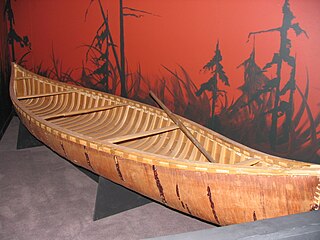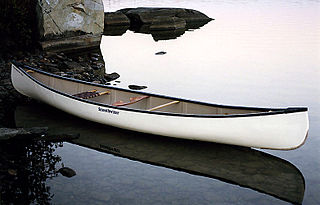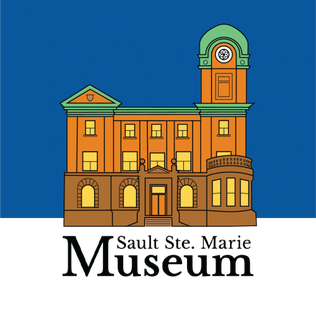
A canoe is a lightweight narrow water vessel, typically pointed at both ends and open on top, propelled by one or more seated or kneeling paddlers facing the direction of travel and using paddles.

The Royal Ontario Museum (ROM) is a museum of art, world culture and natural history in Toronto, Ontario, Canada. It is one of the largest museums in North America and the largest in Canada. It attracts more than one million visitors every year, making it the most-visited museum in Canada. It is north of Queen's Park, in the University of Toronto district, with its main entrance on Bloor Street West. Museum subway station is named after it and, since a 2008 renovation, is decorated to resemble the ROM's collection at the platform level.
The Peel Art Gallery, Museum and Archives (PAMA) is a museum, art gallery, and archives for the Regional Municipality of Peel and are located in Brampton, Ontario, Canada. Previously, it was the Peel Heritage Complex. Its facilities were originally the Peel County Courthouse, Brampton Jail, a land registry office, and a county administration building. It is opposite Gage Park and Brampton City Hall.

The Reynolds-Alberta Museum is an agricultural, industrial, and transportation museum in Wetaskiwin, Alberta, Canada. The museum is situated on an 89-hectare (220-acre) property containing the main museum building, an aviation display hangar, and its storage facility.
The Northern Life Museum is in Fort Smith, Northwest Territories, Canada. The museum has a collection of over 13,000 artifacts representing the peoples and history of the North. Many of the artifacts were collected by the Oblate Fathers and the Grey Nuns during their missionary work in the North.

Birch bark or birchbark is the bark of several Eurasian and North American birch trees of the genus Betula.

The CBC Museum was dedicated to the preserving the physical heritage and archival materials relating to the history of the Canadian Broadcasting Corporation (CBC). It was located in the Canadian Broadcasting Centre at 250 Front Street West, Toronto, Ontario, Canada. The museum collection began by at least 1960, the current display space opened in 1994, and closed on December 22, 2017.
Kevin Callan is a Canadian canoe enthusiast, media personality, and author of thirteen books, including the bestselling The Happy Camper and "A Paddler's Guide To" series.

The Wisconsin Canoe Heritage Museum, located in Spooner, Wisconsin, United States, is a museum dedicated to preserving the history of the canoe. It is the only museum located in the United States that is exclusively dedicated to the preservation and interpretation of the cultural heritage of North American canoe.

Canoeing – recreational boating activity or paddle sport in which you kneel or sit facing forward in an open or closed-decked canoe, and propel yourself with a single-bladed paddle, under your own power.
Kirk Albert Walter Wipper, was a Canadian academic and founder of the Canadian Canoe Museum, which is located in Peterborough, Ontario. He has been called a "pioneer in the development of outdoor education in Canada."

The Nisg̱aʼa Museum is a museum of the Nisg̱aʼa people, located in Lax̱g̱altsʼap, a village in northwestern British Columbia, Canada. The Nisg̱aʼa name means "the heart of Nisg̱aʼa House crests," a name that celebrates the role of tribal crests in Nisg̱aʼa society. The museum is a project of the Nisg̱aʼa Lisims Government and opened in the spring of 2011. It is a place for display of Nisg̱aʼa artifacts, sharing traditions and ideas, and a centre for research and learning. The museum's collection of Nisg̱aʼa culture is "one of the preeminent collections of Northwest Coast aboriginal art" The museum's website states: "This is our gift to each other, our fellow Canadians and the world."

Maine Maritime Museum, formerly the Bath Marine Museum, offers some exhibits about Maine's maritime heritage, culture and the role Maine has played in regional and global maritime activities. Maine Maritime Museum has a large and diverse collection, made up of millions of documents, artifacts and pieces of artwork and includes an extensive research library.

The Peterborough Canoe Company, founded in 1892 by William H. Hill and Elihu Edwards, manufactured wooden canoes in a factory located at the corner of King and Water Streets in the city of Peterborough, Ontario, Canada, where quality wood and wood-canvas canoes and sporting goods were produced until 1961.
Boat building has been a part of the history of Ontario, Canada for thousands of years. From the hand-crafted birch bark canoes of the indigenous people to modern factory-built speedboats, the construction of small boats for fishing, transportation and later water sports has been a widespread commercial activity in the province.
Ottawa River Canoe Club (ORCC) is a non-profit paddling organization in operation since 2002 and located in the west-end of Ottawa, Ontario, Canada. The organization offers a variety of recreational and competitive paddling programs for everyone, including:

Ted Moores is a Canadian boat builder, author, and educator. His book Canoecraft has sold over 300,000 copies worldwide.

Cesar Newashish (1904–1994) was an Atikamekw canoe maker and elder. He was born in 1904 in Manawan, Quebec, a settlement located about 200 kilometres north of Montreal, Quebec.

Canadian is the byname used in some countries for the descendants of the birch bark canoe that was used by the indigenous peoples of Northern America as a convenient means of transportation in the densely forested and impassable areas of Northern America.

Sault Ste. Marie Museum is a museum in Sault Ste. Marie, Ontario, Canada. Built as a post office from 1902 to 1906, this building became a museum in 1982 when it was purchased by the City of Sault Ste. Marie. It is operated by the Sault Ste. Marie & 49th Field Regiment R.C.A. Historical Society.
















